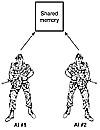- On Action Games
- Choreographed AIs
- Object Tracking
- Chasing
- Evasion
- Patrolling
- Hiding and Taking Cover
- Shooting
- Putting It All Together
- In Closing
Putting It All Together
We have seen the basic routines to move a character, chase other people, and shoot different weapons. But these are all individual tasks, which must somehow be combined. To do so, I will now examine two techniques that allow us to blend these simple behaviors into a rich, engaging AI system: parallel automata and AI synchronization. The techniques we have seen so far will thus behave like bricks in a LEGO game, each serving a specific function or task.
Parallel Automata
The first way to blend different actions together is to use a parallel automata. In this case, the first automata would control locomotion (chasing, evading, patrolling, hiding), whereas a second automata would evaluate the firing opportunities. The algorithm for this solution would be best implemented via state machines (thus, two state variables would be required). You can see this in the following example:
class enemy
{
int locomstate,gunstate;
void recalc();
};
void enemy::recalc()
{
switch (locomstate)
{
state IDLE:
state WALKING:
}
switch (gunstate)
{
state IDLE:
state WALKING:
}
}
We have thus divided the problem in two. Now, the locomotion AI is in charge of tasks such as reaching waypoints, collision detection, seeking cover as needed, and so on. Then, the gunner AI takes care of targeting and shooting down enemies.
AI Synchronization
Another way of combining simple behaviors into complex systems is to make use of AI synchronization. This is generally considered an advanced topic, but adding it to our toolbox of action AI techniques can greatly increase the expressive potential of the overall system—the same way a group of ants looks more intelligent to the observer than an individual ant. Groups of enemies that coordinate, implement tactics, and work as a team are one of the most impressive features of any AI system. This technique was made popular by Half-Life, where enemy soldiers would call for help, cover each other, and operate as a squad realistically.
Implementing enemy synchronization is just a matter of using a shared memory pool, which is visible to all entities and can be written and read by the AIs. Then, the rule systems or finite-state machines must be enhanced to take advantage of this shared memory.
At the simplest level, our shared memory pool can be something like this:
typedef struct
{
bool flags[64];
} sharedmemory;
We need this structure to be visible from all automata, so we can add sentences like this:
if (sharedmemory[3]) state=(É)
As an example, imagine a game that takes place in a prison. The center of the prison is dominated by a large tower with a powerful light cannon, which continually scans the ground at night to prevent inmates from escaping. A simple AI controls the light. Then, there are a few patrol AIs that walk around the complex, and if the player enters their view cone, they chase him and kill him. Now, imagine that the watchtower AI uses a shared memory location to indicate whether the player is actually inside the light cone. If this is so, another memory location stores his position. Then, patrol AIs are implemented just like we discussed earlier, but with an exception. They read the said memory location, and if the player is detected, they run to the location specified by the watchtower. This very simple synchronization, illustrated in Figure 7.8, can yield a significant improvement in the gameplay. The player can voluntarily enter the light cone to be detected, then run away, so guards are sent to an area of the camp while he escapes somewhere else.
 Figure
7.8 Two AIs use the shared memory to communicate.
Figure
7.8 Two AIs use the shared memory to communicate.
More complex synchronization mechanisms can be devised. A soldier can confront the player, and if the player is carrying a more powerful weapon, the soldier can run for cover. Once hidden, he can raise a signal so other AIs can come to help him. Add some radio messages as sound effects, and you have a very credible AI behavior.
Synchronization becomes more complex if we try to model larger groups involved in more sophisticated interactions. If we need to create lifelike behaviors involving dozens of entities, we better use artificial life techniques. These techniques use specific tools to convey the illusion of living entities acting in groups, such as troops, schools of fish, or birds in the sky.